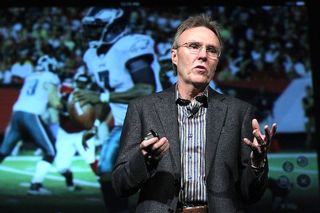SCTE: Comcast’s CTO: ‘Shifts Happen’

Denver--The cable industry must be ready to change and evolve its development models and accelerate its pace of innovation if it is to be prepared to fend off heated competition that’s coming from multiple fronts, including from Web- and cloud-focused online video rivals.
That was a key theme presented during Tuesday morning’s SCTE Cable-Tec Expo opening general session, which that featured keynote presentations and a panel on how cable is evolving to a more cloud-centric, agile model of engineering and product development.
Tony Werner, Comcast Cable’s executive vice president and chief technology officer and the program chairman of this year’s show, summed it all up with this terse phrase: “Shifts happen.”
“We are at a time of great change,” said Werner, who gave some credit to Mike LaJoie, the retiring chief technology officer of Time Warner Cable, for coming up with a term to help put everything into perspective. “We are facing a new wave of competition.”
The good news, is that the cable industry “has been built on change,” Werner said. For example, he noted how channel counts have climbed from the single digits to the hundreds and that the industry is already moving toward an IP-, cloud-based service development and delivery approach.
To handle the competition and to ensure that the industry can pivot quickly, he said cable must focus on three key areas: product, improving customer service, and leveraging scale and technology.
On the product side, cable must start to sweat the details, and not rely on off-the-shelf offerings, but on products that tie in impressive industrial design and packaging. If content is king, rich navigation with content curation and recommendation engines are now “queen,” he said.
Multichannel Newsletter
The smarter way to stay on top of the multichannel video marketplace. Sign up below.
And cable can no longer lean solely on triple-play bundles, but must continue to introduce new growth-stoking services. Among examples, Xfinity Home, Comcast’s home automation and security service, “has shown promise,” Werner said, noting that almost half of those customers are new to Comcast, and about 54% now take four services.
Werner acknowledged that cable has a long way to go when it comes to maintaining customer loyalty as competition grows more heated and consumers now expect the kind of bar-raising experience delivered by companies such as Amazon, Zappos and Uber. “We haven’t lived up to the old bar,” he said.
On the scale front, he said it’s “critical” for cable to continue to leverage industry organizations such as CableLabs, CTAM, the National Cable & Telecommunications Association and the Society of Cable Telecommunications Engineers.
And he said the industry should embrace platforms such as the Reference Design Kit (RDK), plugging the open, pre-integrated software stack being managed by Comcast, TWC and Liberty Global.
Werner and a follow up panel took it all as step further by diving into cable’s increased use of the proverbial cloud, open architectures, and the adoption of the “agile” development model and “DevOps” — ensuring that development and operations teams are working together.
Agile development, Werner said, “takes years out of the process.”
Cloud technologies, when linked to agile and DevOps modeling, is disrupting the way the industry operates, but in a good way, executives said in a follow up panel.
At the app level, it allows operators to deploy services and try out new things at a more rapid pace. “What we need is decision-making that can keep up with the technology,” Geoff Arnold, cloud architect at Cisco Systems, said.
The cloud “is not the tool itself, but the process it enables,” Nick Barcet, vice president of products and presales for eNovance/Red Hat, added.
Shifting operations into the cloud and putting the development and operations teams on the same page “removes a lot of friction from the process,” Mark Muehl, Comcast’s senior vice president, platform technologies, said.
Rob Lloyd, president of development and sales and Cisco, amplified those points in his following cloud-focused keynote.
“We need to pick up the pace of innovation,” Lloyd said.
One way cable can quicken its gait by continuing to put more service smarts in the cloud that can manage and optimize millions of client devices.
That doesn’t mean the client device will disappear. Devices in the home will continue to serve as the model for innovation, Lloyd said, but “home devices [are becoming] a little thinner.”
